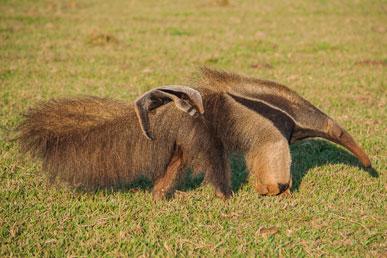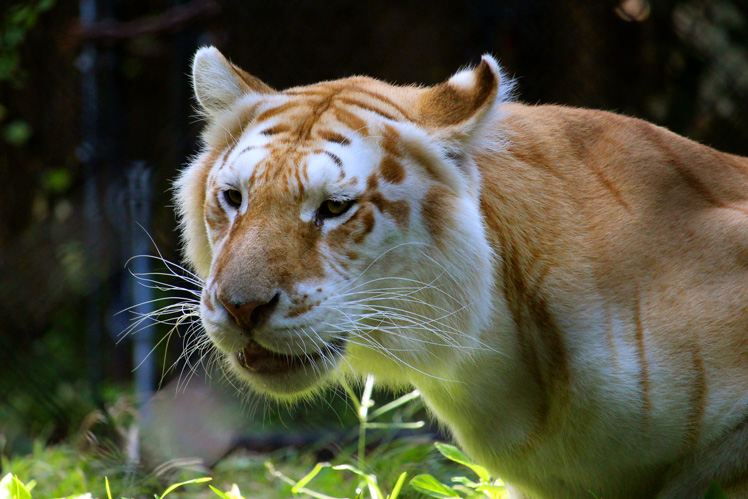
Today we will consider interspecific hybrids formed as a result of mixed marriages between species of the Panther genus: lion, tiger, leopard and jaguar. In nature, such hybrids are almost never found, since their range is isolated from each other. They are known mainly from the results of the joint maintenance of various species of big cats in captivity.
Hybrids between lion and tiger
Tigrolev
Tigrolev (also has the following names: tiglon or taiglon (tiglon), tigon or taigon (tigon), tion (tion): from the English tiger “tiger” and lion “lion”) is a hybrid of a male tiger and a female lioness. Tigerlions are not found in the wild as tigers and lions currently have different ranges.
Such hybridization was most popular in the late 19th and early 20th century, but since the middle of the 20th century, the attention of zoologists has shifted to crossing a female tiger and a male lion, resulting in a liger (more on that later).
Tigerlions combine the characteristics of both parents: they can have spots from their mother (lion cubs are born spotted) and stripes from their father. The mane of the tiger, if it appears, will always be shorter than the mane of the lion. Typically, tigers are smaller than lions and tigers and weigh about 150 kg.
Male tigers are always sterile, while females are not.
In the collection of the Moscow Zoo there was a tigrolev named Apollo, brought in 1935 from Germany, where he was born from a Ussuri tiger and a lioness.
Zoological experts say that the tigrolev may well survive in the wild, unlike the liger. The tiger's running speed can reach 70–75 km/h, which is quite enough for a successful hunt. He also has well developed all the senses.
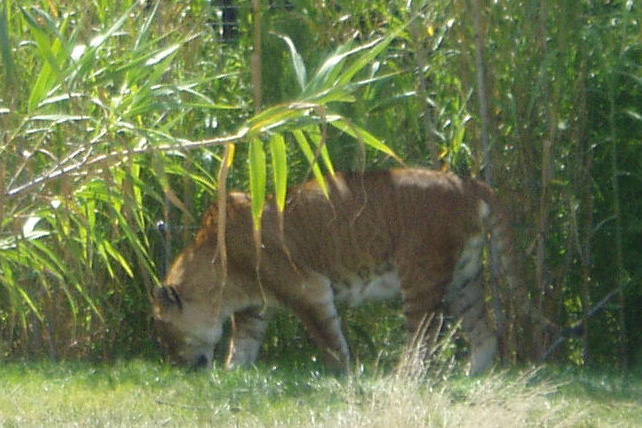
Tygon at Canberra Zoo | wikipedia.org
Ligre
A liger is a hybrid between a male lion and a female tigress. Outwardly, it differs markedly from its opposite hybrid, the tiger. It looks like a giant lion with blurry stripes.
In appearance and size, it is similar to the cave lion, which died out in the Pleistocene, and its relative, the American lion. Ligers are the largest cats in the world today. A liger can reach a length of four meters or more, and weigh more than three hundred kilograms (this is a third more than that of large lions).
Interesting fact
The largest liger is Hercules from the Jungle Island interactive theme park located in Miami, Florida, USA. Its weight is 450 kg, which is twice as heavy as the average lion.
Male ligers, with rare exceptions, have almost no mane and, unlike lions, ligers can and love to swim.
Another feature of ligers is that female ligers (ligers) can produce offspring, which is unusual for hybrids.
Ligers are almost impossible to meet in nature, mainly because lions and tigers have almost no chance of meeting in the natural environment: the modern range of the lion includes mainly central and southern Africa (although the last surviving population of Asiatic lions exists in India), while the tiger – Exclusively Asian. Therefore, species crossing occurs when animals live in the same enclosure or cage for a long time (for example, in a zoo or circus), but only 1-2% of pairs give offspring, which is why there are no more than two dozen ligers in the world today.
Most tigers and ligers were bred in China, in the province of Hainan. The Chinese call the cubs "shihu" if the father is a lion, or "khushi" if the father is a tiger. Usually, kittens weigh 250-270 grams at birth, but after two weeks they are already gaining 1,5 kg. At the age of one month, the cub already weighs 25 kg.
You can see a live liger and tiger in the video at the end of the article.

Liger (left) and liger (right) | wikimedia.org

Liger Zita in Novosibirsk Zoo | wikimedia.org

Liger Hercules during performance | wikimedia.org
Liliger
A liliger is a hybrid between a male lion and a female liger. Like most other hybrids, they do not occur in nature.
The first recorded birth of a liliger took place in early September 2012 at the Novosibirsk Zoo. Parents are Samson the lion and Zita the ligress, born in 2004. The newborn female was named Kiara, at an early age she looks more like a lion cub. Since Zita did not have milk, the liligris was fed by a domestic cat. In mid-May 2013, Samson and Zita gave birth to three more liligrens, all female.
The first case of the birth of a liliger in the United States was registered on November 29, 2013 at the Wynnwood Zoo, Oklahoma. The next day, the same female gave birth to two more cubs. In 2017, the first recorded case of the birth of a male liliger was reported.
In October 2019, employees of the Seaside Safari Park discovered a male liliger named Blag. He was born on February 27, 2012 at the Liger mobile zoo, and entered the safari park in early October 2019 from a mini-zoo on the Vladivostok-Nakhodka highway, where he was considered a liger.
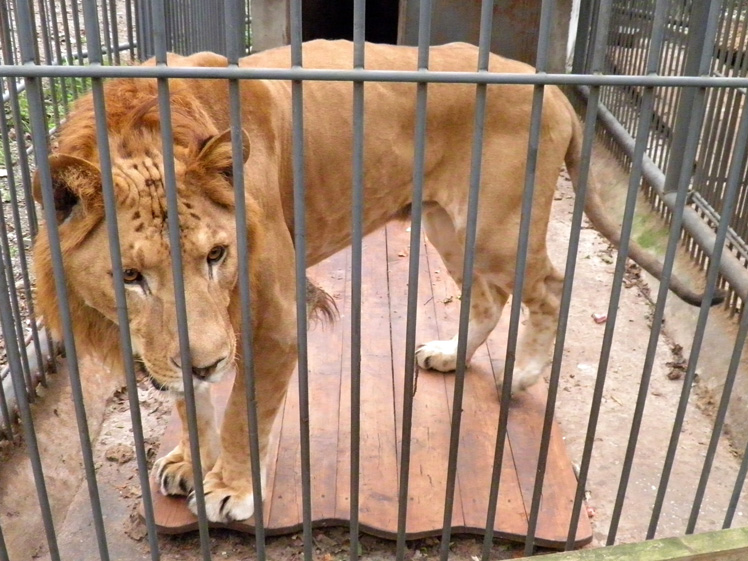
Liligr Blag in Primorsky safari park | wikimedia.org
Hybrids between leopard and lion
Leopon
Leopon is a hybrid of a male leopard and a female lioness. The head of the leopon resembles that of a lion, while the rest of the body resembles that of a leopard. In size, leopons are larger than leopards, but smaller than lions. Male leopons can have a mane about 20 cm long. Leopons have brown (rarely black) spots and a tail with a tassel like a lion.
The first documented birth of a leopon occurred in India in 1910. Then in the Indian city of Kolhapur, Bombay, two leopon cubs were born. One of them died at the age of 2,5 months. Milard, secretary of the Natural History Society in Bombay, sent the skin of the animal to R. Pocock, a British zoologist who first described the animal in 1912. Pocock wrote that the animal resembled a leopard, but the spots on its sides were smaller and closer together than those of the Indian leopard and were brown and indistinct, like the faded spots of an immature lion. The spots on the head, back, abdomen and legs were black and varied in size. The skull and skin of a leopon from Kolhapur is in the British Museum.
Subsequently, leopons began to be bred in most of the major zoos in Europe, in particular in Italy and Germany. Karl Hagenbeck, who described many different hybrids, noted the birth of a leopon at the Hamburg Zoo in Germany, although none of them survived to maturity.
In the Japanese nature reserve on the island of Honshu, scientists have achieved great success compared to zoos in Germany. The first 2 kittens were born in 1959 in the Japanese city of Ninomiya in the Koshien Hanshin park; in 1962, 3 more were born. The parents were the lioness Sonoko and the leopard Kaneo. The cubs were sterile; the last of them died in 1985. The length of females was 1,4–1,6 meters, males 1,5–2,4 meters. All leopons were excellent tree climbers and spent a lot of time in the water.
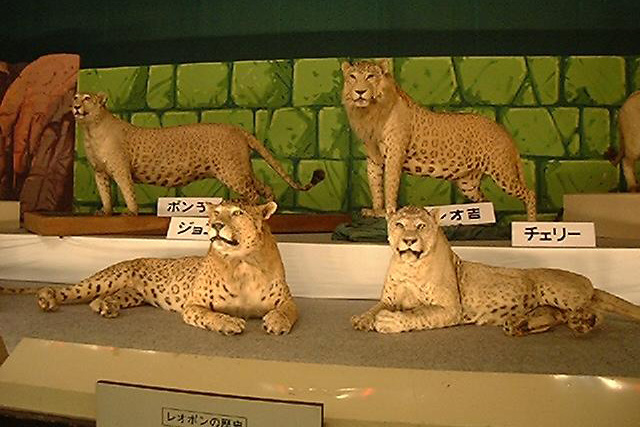
Group of artificial leopons | wikipedia.org
Leard
Leard, or lepard (liard, lipard) is a hybrid between a male lion and a female leopard. These animals retain the appearance of a lion. Large leopard, but smaller than the average male lion. They have a small head and brown spots located throughout the body. On the tail they have a tassel of fur, like those of lions.
The first leard was born at the Schönbrunn Zoo in Vienna in 1951. His father was a two-year-old 250 kg lion, 1,08 meters high at the withers and 1,8 meters long (excluding the tail). The mother was a 3,5-year-old female leopard weighing only 38 kg. After birth, the mother stubbornly protected the cub from the male, and even gnawed through his tail. Soon the girl was handed over for artificial feeding.
Another leard was born in Florence, Italy. The lion and leopard were purchased from the Roman Zoo. The owner had 2 tigers, 2 lions and a leopard. The cubs were not expected, but still the female leopard gave birth to a new kind of kitten, which was completely unexpected for the owner. The cub had the body of a lion with a large head (lion) and a receding forehead (from a leopard), yellowish brown and thick fur. When the kitten was 5 months old, the owner sold it and decided to seriously start breeding a new hybrid. However, such attempts were in vain.
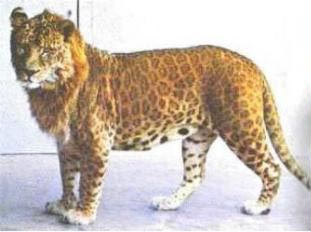
Leard | wikipedia.org
Hybrids between leopard and tiger
Dogla
Dogla is a hybrid between a male leopard and a female tiger.
Indian folklore claims that the appearance of a cub from a tiger and a leopard is quite natural. There are some documents that say: "His head and tail were like those of a black leopard, but the body, shoulders were of a tiger. The colors of the leopard and tiger merged into one, the stripes were black, wide and long, dots were visible on some parts of the body".
Tigard
A tigard is a big cat hybrid between a male tiger and a female leopard.
In 1900, Karl Hagenbeck crossed a female leopard with a Bengal tiger. The stillborn calf had a mixture of spots and stripes. On April 25, 1908, Henry Sheren reported that he crossed a tiger with two female Indian leopards and both times they brought offspring, but no one saw the kittens.
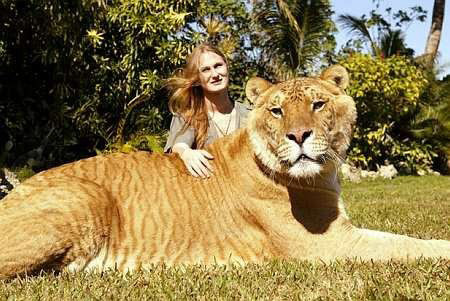
Tigard | wikipedia.org

Male tigard | wikipedia.org
Hybrids between jaguar and lion
Yaglev
Yaglev or yaglon, jaglion (jaglion) is a hybrid between a male jaguar and a female lion.
Yaglevs are predominantly melanistic, sometimes brown-red or dark red. Anatomically similar to African lions. Males have a short thick black mane.
Two jaglevs were born on April 9, 2006 in the Canadian reserve Bear Creek Wildlife Sanctuary, Ontario. Their parents (the lioness Lola and the black jaguar Diablo) were accidentally crossed as a result of a close relationship since childhood, as they grew up in the same unit. Their children, the melanistic girl Jahzara and the boy Tsunami, are the only living representatives of the yaglev. You can see them in the video at the end of the article.
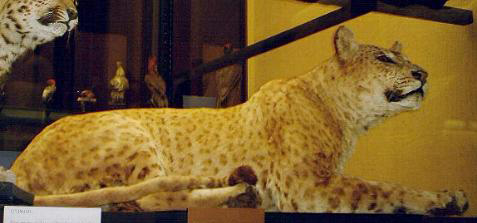
Stuffed Yaglev at the Rothschild Museum, Tring, England | wikipedia.org
Liguar
A liguar is a hybrid between a male lion and a female jaguar. These are quite rare hybrids compared to other big cat hybrids.
Hybrids between jaguar and leopard
Yagupard
Jagupard is a hybrid of a male jaguar and a female leopard. There are names jagulep and yagleop (jagulep, jagleop). In nature, such hybrids do not appear, since leopards and jaguars cannot meet by chance (they live on different continents). Jaguars are found in Central and South America, while leopards are found in Africa and Asia.
The jagupard is more massive than the leopard. It usually has a golden-orange coat with large irregular rosettes covering the body, which in places form a circular pattern around the paws and head. Between the paws and on the belly, the hair is lighter. The hybrids of jaguar and leopard that appeared as a result of interbreeding in zoos were described as cats with short and thick legs and neck, dark red, gray-brown and steel gray hair. The rosettes on the chest are usually faded.
Only rare cases are known when the female gave birth to offspring. For example, jagupard cubs were born in the zoos of Chicago and Salzburg.
Lepyag
Lepjag (lepjag) – a hybrid of a leopard and a jaguar, if the father was a leopard, and the mother is a female jaguar.
Hybrids between jaguar and tiger
Tiguar (tiguar) – in the Mexican zoo, a crossing was carried out between a male Amur tiger and a female jaguar. As of June 2009, the cub weighed 180 kg.
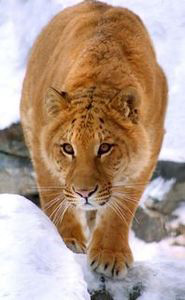
Tiguar | wikipedia.org
Hybrids between puma and leopard
Pumapard is a hybrid of a puma and a leopard. It can appear only in captivity, since the natural ranges of these species do not intersect.
The pumapard is prone to dwarfism and is half the size of its parent species. In body structure, he looks like a puma. Its legs are short and its tail is long. Individuals of different colors are known: sandy, dark yellow or gray-brown. There are spots on the skin, like a leopard, but not as bright.
The first information about the appearance of a hybrid in the Ringling Brothers Circus was published in The Chicago Chronicle on April 25, 1896, after which the animal supplier Karl Hagenbeck delivered the animal to Great Britain in 1898, where the stuffed animal was preserved in the Museum of Natural History in Tring. Hagenberg's pumapard was reared by a female fox terrier and they were pictured together in the original photo.
In addition, Hagenbeck provided the result of the backcross, the lepuma, to the Berlin Zoo, where this animal was described by Ludwig Heck. In 1908, this animal was described by Henry Sherren.
A stuffed pumapard is kept at the Natural History Museum at Tring, England.

Stuffed pumapard | wikimedia.org
Liger and tiger
Yaglev Jahzara and Tsunami from Barry Exotic Wildlife Sanctuary, Ontario, Canada
We also recommend:
◆Yeti Crab, Spotted Dolphin, Long-nosed Philodrias, Nambat, Hornbill: the most unusual animals










